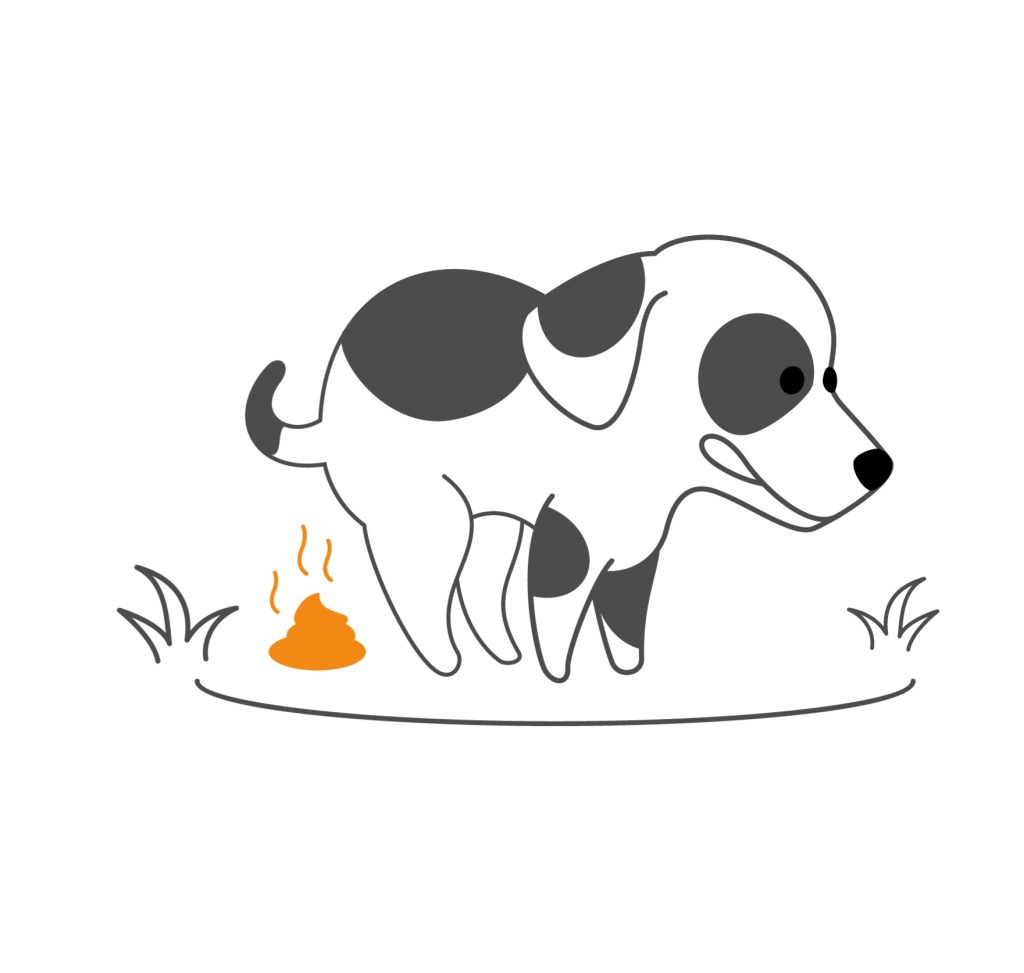Your pet’s faeces can tell you a alot about their overall health and wellbeing. While it might not be the most glamorous topic, paying attention to what you scoop from the litter tray or pick up on your dog’s walk can help you spot potential issues early.
A healthy stool should be log-shaped, hold its form when picked up, have a soft yet firm consistency, and be chocolate brown in colour. Anything outside of this can tell you more about your pet’s digestion, diet, or even underlying health concerns.
So, what exactly should you be looking for? There are five main indicators that can help you understand what your cat’s or dog’s poop might be telling you.
The first indicator is the colour
The colour of your pet’s stool can tell a lot about their internal health. A normal, healthy stool is usually chocolate brown. Slight variations in shade are fine, but significant colour changes can signal dietary imbalances or potential health concerns.
Green
Green stool can appear for several reasons. It may be caused by eating too much grass, but it can also point to more serious issues such as parasites, gallbladder problems, or intestinal infections. If your pet is regularly eating grass, it could also indicate stress or an upset stomach.
Orange or Yellow
Stool with an orange or yellow tint can suggest liver or bile duct issues. If the colour change can’t be linked to diet, it’s best to book a vet appointment. Slightly yellow-brown stool is usually fine, and bright orange stool might also appear after eating certain foods such as pumpkin or carrot. For raw-fed dogs, too much organ meat can also cause orange-coloured faeces.
Pink or Red
If your pet’s stool appears pinkish or red, it’s important to contact your vet. This colour may indicate intestinal problems, infections, polyps, or trauma to the rectum, all of which need medical attention.
Purple
Purple stool can sometimes result from eating deeply coloured vegetables. However, if your pet hasn’t eaten anything that explains the colour, it’s safest to see a vet. For cats, purple stool is concerning since their carnivorous diet rarely includes vegetables, and a veterinary check is strongly advised.
Greasy or Grey
A greasy or pale grey stool can occur when there’s too much fat in your pet’s diet. It may also signal bile duct or pancreatic issues, so it’s worth discussing with your vet if you see this regularly.
Black
Black stool is a red flag, as it often indicates digested blood from bleeding in the upper gastrointestinal tract or stomach. In raw-fed dogs, dark or black stool may simply result from a diet rich in darker meats such as beef or venison, or from organ meats like liver. Contact your vet as soon as possible if you see black stool in your dog and they are not raw-fed, or they are raw fed and it can’t be explained by something they ate.
White
White or chalky faeces usually suggest an excess of calcium in the diet, and are often seen when a pet has eaten bones. While this may be diet-related, persistent white stool should still be mentioned to your vet.

The second indicator is consistency
The consistency of your pet’s stool can tell you a lot about their digestion and overall health. A healthy stool should be log-shaped, have a soft but formed texture, and hold its shape when picked up. Anything firmer or looser may point to an imbalance or underlying issue.
Diarrhoea
When a pet has diarrhoea, the stool becomes watery and loses its shape completely. This can happen for many reasons, from something minor, like a sudden change in diet, to more serious underlying health problems. Persistent or severe diarrhoea should always be checked by a vet. In very young or elderly pets, diarrhoea can quickly lead to dehydration, so veterinary attention is needed. If you notice blood, unusual colours, or mucus in the stool, it should be treated as an emergency.
Constipation or Hard Stool
Hard or dry stools often appear as small balls or pellets rather than formed logs. This may happen when your pet isn’t getting enough fibre or water, but it can also be linked to kidney or digestive issues. If your pet is straining to poop, or if constipation continues for more than a day or two, a vet visit is needed to identify and treat the underlying cause.
Amount
The amount of stool your pet produces should generally reflect how much they eat. A noticeable increase or decrease in the amount of stool could suggest dietary issues, malabsorption, or other health concerns, especially if it happens suddenly or alongside other changes.
The third indicator is content
When checking your pet’s faeces, it’s important to look at what might be in or on it. The contents can offer valuable clues about your pet’s health and habits.
If you notice white specks or small rice-like dots, this could indicate the presence of parasitic worms. In this case, your pet will need to be dewormed with medication targeting the specific type of worm.
Faeces containing inedible objects such as plastic, fabric, or other unusual materials may suggest your pet has been eating things they shouldn’t, which can sometimes lead to a blockage. Pets that tend to chew or swallow non-food items should be monitored closely, and their environment kept tidy with potential hazards out of reach.
A furry stool can appear in pets that over-groom, especially cats. While small amounts of fur are usually harmless, excessive ingestion can cause digestive discomfort or, in rare cases, a blockage.
If you see red streaks or spots in the stool, this often points to a small tear or irritation around the anus, which should be checked by a vet to rule out other causes such as infection or inflammation.
The fourth indicator is coating
A healthy stool should have a smooth surface and be easy to pick up without leaving residue behind. If your pet’s faeces have a mucus coating, it usually signals inflammation in the intestinal tract, often linked to gastrointestinal issues. The inflammation can be caused by parasites, viruses, bacterial infections, or food allergies.
Occasional traces of mucus might not be a concern, especially if your pet’s diet recently changed or if they experienced mild digestive upset. However, if the mucus is persistent, excessive, or accompanied by other changes such as diarrhoea, blood, or loss of appetite, a vet examination is recommended to identify and treat the underlying cause.
The fifth indicator is smell
Your pet’s stool will naturally have some odour, but a sudden change or unusually strong smell can point to a digestive issue. Causes may include dietary changes, food intolerances, infections, or problems with nutrient absorption. If the odour remains strong or unpleasant over several days, or if it’s combined with changes in colour or consistency, it’s best to have your pet checked by a vet to rule out underlying issues.
Conclusion
It might not be the most glamorous topic, but your pet’s faeces are an important indicator of their health. We hope this article has helped highlight why it’s worth keeping an eye on your pet’s toilet habits and what different types of stools can tell you.
At Paw Pals, we always monitor the pets in our care closely, including their stool, and note any changes in their daily report. It’s one of the many ways we make sure your furry family members stay healthy and happy. If you wish to know more about our puppy sitting, dog walking, pet relocation or dog training services, feel free to contact us.

